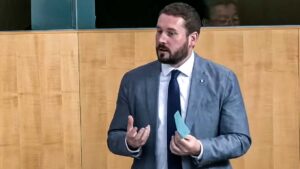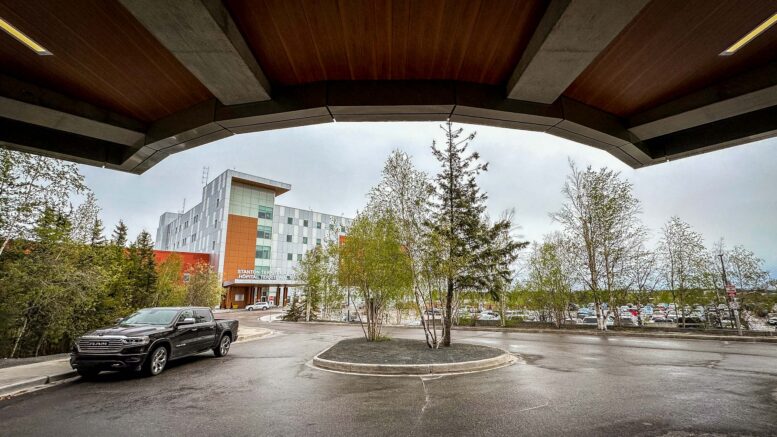Two months ago, the NWT Health and Social Services Authority announced new options for accessing outpatient lab services at Stanton Territorial Hospital, effective immediately.
However, the suite of ways to access outpatient lab services at Stanton has soured some feelings among clients who preferred the old method, the NWT Assembly heard today.
 Julian Morse is the MLA for Frame Lake in Yellowknife.
Julian Morse is the MLA for Frame Lake in Yellowknife.
“I am concerned this new process is going to be a barrier for a single mother, elderly person, someone with ability challenges, or any other person with vulnerabilities or life demands that are going to override their capacity to engage in this process,” he said in the NWT Assembly on Thursday, the final day of the spring sitting.
“I suspect there were a number of people who are already struggling to go directly to the labs after the medical appointment. MLAs often makes statements fighting for change in our healthcare system. But in this case, I think we have an example where changes caused new problems rather than solving one.”
When announcing the changes in April, the Health Authority stated clients could use the Stanton Hospital services the same way they always have.
That means visiting the lab at at a time that works best for during the hours they are open. The person’s will be added to the waitlist for the next available opening.
Or, clients can call ahead and book a future date and time that is convenient.
Appointments can be made by calling (867) 767-9300 ext. 46673 between 9:00 a.m. and 4:00 p.m. Monday to Friday.
Alternatively, clients can also now visit the lab at Stanton and if available, be provided with a time slot for later that same day. This will allow people to leave and come back at their designated time slot, designed to eliminate the overflow seen at times in the main waiting room, and give residents some flexibility in their day.

Frame Lake MLA Julian Morse speaks about new appointment system for lab tests in Yellowknife. (Image courtesy Assembly Livestream.)
But Morse says some of his constituents just can’t crack the lab access code.
Lesa Semmler is the NWT’s Health Minister.
She said no review of the policy changes is necessary, but more communications are required.
“With any new process that rolls out … there are some difficulties … (but) we are implementing the program,” she said.
“We have heard a lot of positives as well.”
Semmler said in the past month, 200 more people were able to be seen.
There is no longer a convenient test access point for downtown clients using the Primary Care Centre, which is only providing select services.
The downtown lab has been shut since the start of the year. The Frame Lake Clinic is completely closed, with appointments are now at the Old Stanton building, re-opened as the Łıwegǫ̀atì (kle-wa-goon-tea) Building.
Also, on the final day of the spring session:
Members of the 20th Legislative Assembly have approved a slightly fatter budget than the proposed Budget 2024-2025. Initially presented on May 24, the plan proposed to spend $2.2 billion on programs and services, but pressure from Regular MLAs forced Finance Minister Caroline Wawzonek’s hand to spend an additional $13.3 million.
A few Budget 2024-2025 highlights: early childhood instructors ($3.5 million ongoing); maintenance and repair of public housing ($3 million); ten housing units in Łutselkʼe ($580,000); Aurora College transition planning ($500,000); reinstatement of positions for the midwifery program ($331,000 ongoing); and continued operation of the Fort Smith Correctional Centre for the budget year.
Also, Simpson released mandate letters for all members of Cabinet, which set out the Premier’s expectations for how ministers will advance the 20th Legislative Assembly’s priorities.
While most letters were three pages long, and shared much of the same language, the letter for the Justice Minister, Government House Leader and Minister of Executive and Indigenous Affairs was five pages of much tinier print. Those many portfolios are held by the same person, Premier Simpson.
And as he returned from a Western Premiers Conference in Nunavut and Yukon, the Premier joined his colleagues in calling on Ottawa to modernize emergency response policies and funding.
“Over the last decade, the territories have experienced unprecedented growth in the frequency and severity of drought, wildfires, and floods driven by climate change,” reads a conference communique.
“Territories do not have the fiscal capacity to fund ongoing disaster management at the current scale. It is clear that there is a need for a new and sustainable federal approach to respond to the resulting emergencies
“These changes must ensure timely, flexible, adequate, and culturally appropriate support and funding is available in responding to emergency events, and to provide additional disaster mitigation funding to better prepare northern communities for future threats.”

Former cabinet minister, Regular MLA, and Speaker of the House, Tłı̨chǫ Grand Chief Jackson Lafferty, was welcomed back to the NWT Assembly on Thursday as he sat in the public gallery. Lafferty was a Member of the 15th, 16th, 17th, 18th, and 19th assemblies. (Image courtesy Assembly Livestream.)





